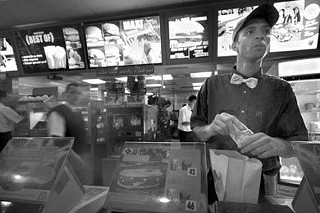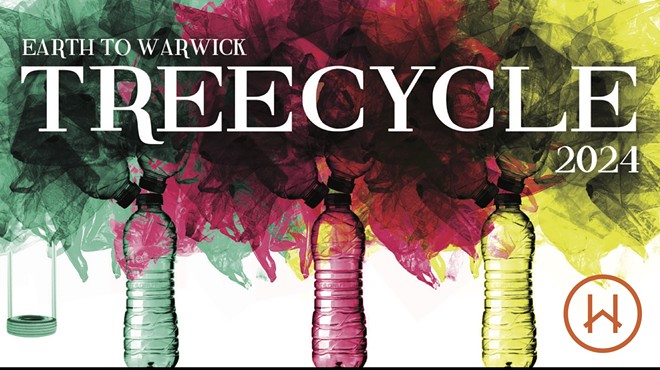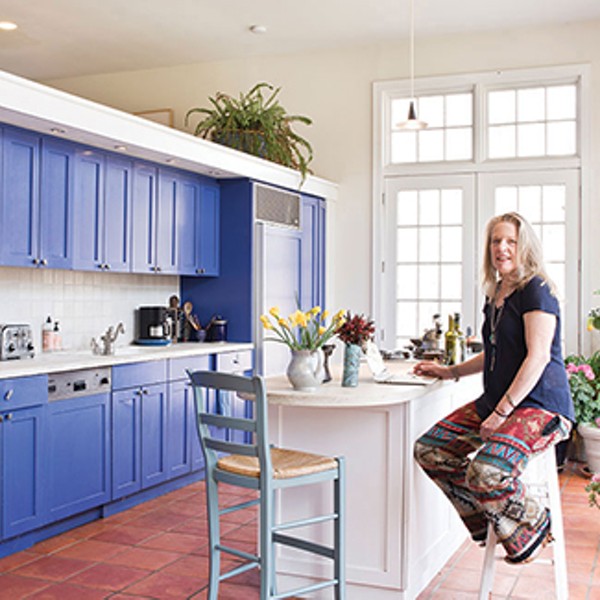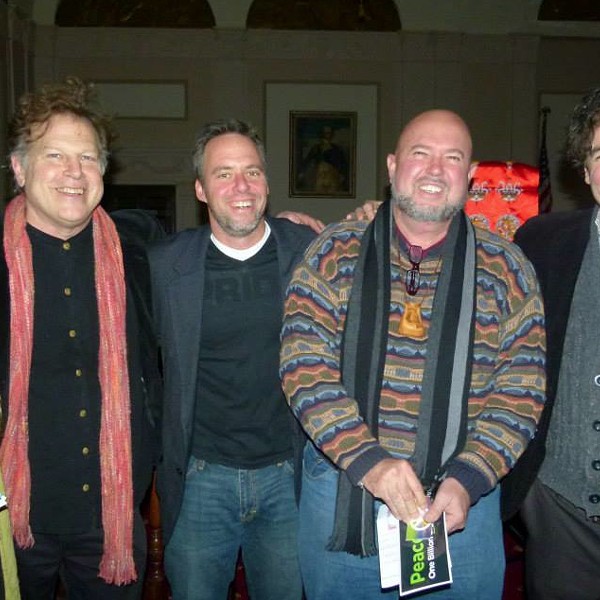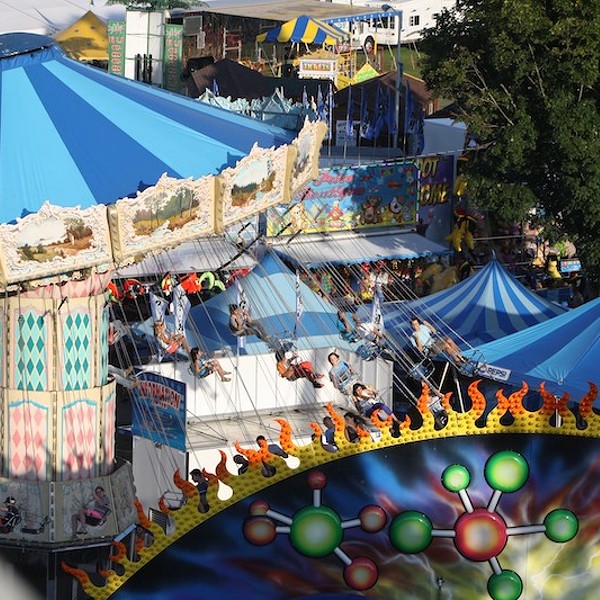Hi, Lorna. This is Arthur. Do you want to go to Morocco?
Sure.
Call this number. Do it now.
It was that simple. Three weeks after my return from Iraq on March 20, I received a call from Arthur Romano, a young, deeply committed peace activist who has been doing community outreach for the World Peace Prayer Society in Amenia since 1998. The mission to Morocco centered on the invitation that Arthur's band, The Peace Project, received to play at the 39th National Festival of Public Arts, historically a showcase for Moroccan-only troupes and artists. This was only the second year internationals had been invited to perform. More important, this was the first year that Americans were invited. The Mid-Hudson Valley-based Peace Project was America's sole ambassador.
The invitation came via The Friendship Caravan, a non-profit organization founded by Michael Kirtley, a former photojournalist whose work has appeared in National Geographic, Life, and Geo and who has spent the last 30 years living and working in Africa. Deeply affected by the 9/11 terrorist attacks and the ensuing tension and fear generated between Americans and Arab Muslims, Kirtley created Caravan in an attempt to build a bridge of understanding between the two cultures. Through his deep ties to Morocco, he contacted the government there and began to work out a series of "bridge building" delegations. The first occurred in February when Kirtley brought eight members of a non-proselytizing Christian evangelical association to Marrakech. The eight-day visit was so successful that it spawned plans for a three-day Christian music festival to be held sometime next spring.
"The Moroccan overture is a great beginning," said Rev. Richard Cizik, of the National Evangelical Association. "It's a bold step by both faith communities to showcase cooperation and mutual respect in a conflict-weary world."
A ROAD TO MOROCCO
For me, this was what is known as a press junket: all expenses-airfare, hotel, two meals daily, and in some cases ground transportation-paid for by the host country. It was not without trepidation that I accepted this invitation, as the host typically assumes that the invitee will write positive articles about the country and the event. But I was clear with Kirtley of my intention-to explore this new cultural territory located in the western-most edge of the Arabic world, a 90-percent Muslim country where, according to a Pew Global Attitudes Project survey, 73 percent of Moroccans had "unfavorable attitudes" toward Christians; to write about the festival in relation to the Peace Project; and, bottom line, to write about whatever I wanted.
Morocco is a lusher, greener, cleaner, and much more relaxed version of Iraq. The similarities between the two in architecture and roadways are striking, but there is none of the fatigue, depletion, and neglect brought on by the 10 years of the Iran-Iraq war followed by 12 years of US-backed sanctions that I have seen in Iraq. The sights and smells of Morocco also remind me of Mexico with its open cooking fires filling the air and its concrete block stucco-covered construction. Many buildings are painted in cooling tones of salmon and peach. Others are white with a sea-blue trim on a door here or an archway there. I was told that at one time the blue and white motif was intentional, symbolic of the presence of Morocco's one-time flourishing Jewish population, but I could not verify this. But the touristy fortress city of Essaouira, located along Morocco's mid-Atlantic coastline, boasts the blue and white colors of the Israeli flag in its seaside tiled sidewalks and on its painted curbs and buildings.
Today's Morocco is a mixture of the original Berber peoples combined with Arab, Roman, French, Spanish, and Portuguese influences. Many languages abound, but most Moroccans can be heard speaking Arabic or French, or an easy-on-the-ear mixture of both. Most remarkable to me is the relaxed atmosphere-so relaxed that I forget I am in the Arab world. Women wear veils or pastel-colored abayas, loose robes worn from head to toe; others wear midriff-baring tank-tops and capris. Color is everywhere-exotic-tinged pointy-toed sultaness slippers and shoes in pinks, ocean blues, bright yellows, blood reds, and silky multi-color stripes, many adorned with beads and sparkles. Round-toed leather slippers, shoes, and sandals for men and women come in bright and neutral colors. All can be bought in the souks, or open-air markets, for a few dollars.
ONE THOUSAND AND ONE WILD NIGHTS
The city of Marrakech, the site of the festival, is known as the gateway to the Sahara. Its New Town is modern and cosmopolitan, with office buildings, banks, hotels, restaurants, Internet cafes, and shops of all kinds. The sights and sounds of its Old Town conjures up scenes and characters from the tales of the Thousand and One Nights. Nowhere is this more apparent than in the city's center, Jemaa El Fna, where characters seem to have stepped right out of the pages of the book and into the narrow streets. Over the ages, caravans crossing the desert to and from Algeria, Mali, and Niger would stop here to rest. Today a huge medina is surrounded by uncountable souks selling all things imaginable amid twisting alleyways and narrow paths. Tourists mingle with Moroccans, everyone shopping, eating, and seeking entertainment.
No cars are allowed in this area, so taxis drop you off at the edge of the square. The average trip from a hotel to the medina costs about 20 Dirham, or $1 US. The atmosphere is fantastical. Snake charmers calmly slip their cold-blooded captives around the necks of passersby, asking only afterward for a few Dirhams in exchange for this touch with the exotic. In the evening, large circles gather around musicians, dancers, acrobats, jugglers, storytellers, trained monkeys, young men boxing, and all sorts of other entertainment. An especially large circle surrounds a group of dancing men colorfully attired in women's clothes. Young men approach, offer to take your money and return with your choice of hashish, opium, or both.
There are open-air eateries where cooks and waiters hawk menus. All items are on display, including lamb heads and livers. Kabobs of chicken, lamb, beef, and seafood are only side dishes to a variety of salads-eggplant, beet, spinach, and different types of slaws. Trays of fried shrimp and calamari sit next to heaping platters of couscous, steaming pots of stewing vegetables, and of course olives, bowls and bowls of many varieties. If you don't care for the soda served up at these stands, fresh-squeezed orange juice is sold at other stands, where men perform stunts and jokes to attract customers.
THE PATH TO MODERNIZATION
I have been reading the books of Morocco's leading feminist writer, Fatema Mernissi. Islam and Democracy speaks about "the irreversible trend of democracy" in Morocco. Mernissi contends that satellite communication will have a powerful impact on Islam, Morocco's emerging democracy, and women's freedom, and that the sharing of views and culture among "peace-nurturing citizens" of the East and West can subdue terrorism. Beyond the Veil is an exploration of male-female dynamics in modern Muslim society. In Scheherazade Goes West: Different Cultures, Different Harems, Mernissi investigates and compares gender relations in Europe and in the Arab world.
Democracy is very much on the minds of Moroccans, especially due to the actions of their new king, Mohammed VI. Almost immediately after his succession to the throne following the death of his father, King Hussan II, in 1999, King Mohammed VI took steps to energize the Moroccan society toward democracy, modernization of the economy, and stronger ties with Europe and America. Promising tolerance and respect for human rights, he released political prisoners jailed by his father and allowed dissidents to return from exile. With his sweeping reforms of women's rights and liberal agenda, he made it clear he was bent on bringing this ancient monarchy into the 21st century. Not an easy task-his goal is loathed by extremists, not just in Morocco but throughout the Middle East, who link modernization with Westernization and fear the loss of their culture.
One of King Mohammed's highest priorities has been to reform the Moroccan Family Law, or Moudawana, a mixture of customs and Islamic law that has historically denied basic human rights for women. Among other functions, the Moudawana governs the relationship between a husband and wife, even before the wedding. Traditionally, men have all the rights in a marriage and none of the responsibilities. They can marry up to four women, divorce their wives at will while automatically gaining control of all assets and properties-even those from before the marriage. This in itself has forced many women out onto the streets. In addition, a woman's father has guardianship over her and could marry her off to any man he chose, regardless of her wishes.
"The Moudawana is really a type of violence, judicial violence against Moroccan women," says Damia Benkhouya, a Moroccan women's rights activist. "It entirely goes against the reality of Moroccan women by not including them as part of society, by not allowing them to participate in development in all areas-political, economic, social, and cultural. When you look at the Moudawana, women are always inferior. The Moudawana is really, in fact, about being your husband's slave."
The King's proposed reforms allow for more freedom and rights in marriage and divorce. The age of marriage for women was raised from 14 to 18, and women now have the right to divorce their husbands while retaining an equal share of all property and assets acquired during marriage. Guidelines were set up along Islamic law make polygamy virtually impossible; men looking to marry a second wife would be required to prove they could support a second wife and children from the union equally with the first wife and her children. In addition, the first wife would need to give her husband permission to marry the second. Changes to the Moudawana also support a literacy program, backed by the World Bank, for rural women, 60 percent of whom are illiterate.
In addition and perhaps more importantly, 30 of the 325 seats of the parliament were set aside to be filled by women by way of the 2002 national elections. (In comparison, under Iraq's new Constitution, women won a 25 percent representation in a forthcoming Transitional National Assembly, but it is uncertain whether this percentage will remain under the newest or future governing bodies.) At present, 35 of the elected members of Parliament in the Moroccan House of Representatives are female. According to a BBC report, they "have a higher level of education than their male counterparts, and most have had to work harder than the men to get there."
In the time since these reforms were proposed, women's groups have sprung up and are taking charge of sectors of educating other women, and have created schools for women in rural areas, where girls come from as far as 15 miles away to attend class.
Indeed, the king himself set an example of change and modernity by marrying a 24-year-old computer engineer in March of 2002 in a private ceremony. At the public royal wedding celebration that followed in April, the king broke with the ancient tradition of keeping royal wives hidden from view and presented her to the world. Almost every Moroccan mentioned this to me whenever the King's name came up in conversation.
PROPOSALS OF CHANGE VS. REALITY
When the changes to the Moudawana were first introduced, 40,000 supporters rallied in Morocco's political capital city of Rabat. The demonstration was held in conjunction with International Women's Day 2000. Just four days later, 400,000 fundamentalists flooded Casablanca in a counter demonstration denouncing the changes. "Moroccan women reject these plans imposed by the West, while Sharia recognizes women's rights and protects them," spokeswoman Nadia Yassine was reported to have said at the time. It was argued that the reforms were against Islam's Sharia law and bowed to Western standards. Yassine claimed that the Prophet Mohammed was himself effectively a feminist and that any changes to the social law should be made within a Muslim context.
No stranger to conflict, Yassine's father, Sheik Abdesalam Yassine, a leader of the Islamic group Al Adl Wal Ihsan or "Justice and Charity," was kept under house arrest for 10 years by the former King. The Sheik had sent a letter accusing King Hussan II of tolerating corruption and encouraging Western-style moral decay. King Mohammed VI released him as part of his modernization program.
After the 2000 demonstrations, the government abandoned the reforms. But the King intervened and set up a Royal Commission, comprised of both Islamic scholars and women's representatives. Changes were made accordingly and now even Nadia Yassine reportedly backs the King's Moudawana. In terms of women's rights, Morocco appears to be the most progressive Arab state, at least on paper. Critics argue that in some cases, the reality of the law has yet to reach all the corners of the small country. Yet most women I spoke with agreed that the changes have made a difference in their lives.
Amina, 50-year-old mother of two grown children, lives in the orphanage she manages. Her salary includes all living expenses. Barely one month after the changes in the Moudawana were signed into law, she went to a lawyer and began divorce proceedings against her husband of 30 years. "I work from 7am to 11pm. I left everything behind just to be free. I was working my whole life and supporting my husband. He would beat me from time to time and there was nothing I could do about it. There was no protection from the law and I was not allowed to divorce him. I was waiting for these changes." Amina claims the divorce rate has increased tremendously since the changes to the law, but I could not confirm this.
There are others who do not experience the effect of the changes. In rural areas where illiteracy levels are very high, women may have heard about the new laws but have no idea what they are. "My servant girl, once her mother died, her aunt came and took her away," said Kareema, a 30-year-old businesswomen. "The aunt claimed she needed her to work around the house. The girl thought she had no choice in the matter because she doesn't understand the law because she cannot even read. And I was teaching her how to read."
BEHIND THE VEIL
Morocco's domestic problems are many. One third of Morocco's population of 30 million is extremely poor, and unemployment abounds. Infant mortality rates are high, and 45 in 1,000 children do not reach their fifth birthday. While overall adult literacy weighs in at 52 percent, a closer look shows a great disparity between males (66 percent) and females (38 percent). Domestic violence has long been a huge problem. Agriculture and tourism are the country's economic mainstays. However, drought and floods occur frequently, and tourism took a major hit after the terrorist attacks of 9/11.
In May of this year, the New York Times reported the "Morocco connection emerging as [a] sleeper threat" in the war on terror. Citing the inability of the Moroccan and European intelligence communities to break into the terrorist communications systems until this past year or to identify major Moroccan terrorists, the article said the "significance" of the Moroccan militant branch of Islam has been "missed."
Indeed, none were more shocked than Moroccans when a series of suicide bombs exploded in four sites in Casablanca in May of 2003 at approximately the same time, killing 41 people and injuring dozens more. Moroccans reportedly complained that Europe intelligence officials did not help enough to find the culprits in the aftermath of the attacks. Whether that is true or not, there can be no denying that the Europeans did get a wake-up call on March 11, 2004, when the Moroccan branch of terrorism arrived in Madrid, Spain, and left their calling card in the form of train bombings that killed 191 people.
And then there is the matter of the Spanish government indicting 36-year-old Amer el-Azizi, a Moroccan who reportedly spent time in training in Al Qaeda camps in Afghanistan. The indictment claims el-Azizi was working with a Spanish Qaeda group that helped plan the 9/11 attacks. He is said to be linked, along with other Moroccan Islamic extremists, to the attacks in Casablanca, and is wanted by the FBI in connection to 9/11.
And a recent New York Times report claims the American war on terror has opened "a new front" spanning "the largely ungoverned swath of territory stretching from the Horn of Africa to the western Sahara's Atlantic coast" that "military officials fear could become the next base for Al Qaeda"-a "new Afghanistan." The article goes on to say that the US military's European Command "has asked for $125 million dollars" to be spent in the region over the next five years. "The program, called the Pan-Sahel Initiative, was begun with $7 million and focused on Mali, Mauritania, Niger, and Chad." All are neighbors of Morocco.
ENTER THE PEACE PROJECT
In response to the acknowledged activities of Moroccan militant Islamists, and the threat they pose both to the war on terror and to the emerging democracy fostered by the young king, the Moroccan government has begun a campaign to open dialogue and create avenues of exchange between Arabs and Americans. The purpose is to fight stereotypes and dispel the many misconceptions between the two that were heightened in the aftermath of the 9/11 terror attacks. Most Americans don't realize that the majority of people in countries such as Morocco fear their governments' being overrun by religious extremists even more than Americans do. Only in this context can one understand the importance of this lone invitation to the Mid-Hudson Valley's homegrown American Peace Project to Marrakech's National Festival of Public Arts.
All but one of the band's members-Dennie Kirtley, percussionist and trumpeter extraordinaire and brother of organizer Kirtley-live in the Mid-Hudson Valley. Arthur, the band's poet and spoken-word artist, met lead singer and songwriter Alysun Panichi, translator Katya Gagnon-Huber, and angelic harpist Ken Kuter at the Omega Institute. The rest of the band-internationally acclaimed drummer David "The Waz" Wasiik, bassist Carl Raacke, and rock guitarist Noah Griffen-are all well-known and highly talented Hudson Valley musicians. All are brilliant, insightful and extrordinary in very separate and different ways. All are interested in sending out a strong message of peace.
And indeed they did. In the 10 or more days they had in Marrakech, the band managed to create harmony through art. The magic began at the first night's performance before the thundering, multi-distracted crowd of the medina as people thronged to the stage to hear these Americans play their funky, soulful, jazzy brand of improvisation. For their second performance they extended an invitation to the much beloved Moroccan pop star Hamid Bouchnak to perform along with them. The crowd went wild as Hamid and Alysun melted their voices together with the improvisational accompaniment of the band in what began to be known as "fusion" amid the festival goers in Marrakech-fusion of the voices, fusion of the cultures, fusion of the people in front of the stage. Women in abayas and young men dancing in the aisles were equally affected by this coming together, and many openly acknowledged they understood the message of peace. After the last and third night's performance at the historic Royal Theater, where the stage was shared once again, this time with Moroccan diva Karima Skalli and the famous Moroccan lutist Nouman Lahlou, widely known throughout the Middle East, the band had become the talk of the town.
Wherever band members walked-in the medina, in the hotel, or on the street-these new fans, Moroccan, African, and European, approached them. All had seen one or more of the performances and were deeply affected by them. Even days later, when a few of us took a two-hour bus ride to the seaside town of Essaouira, people in the restaurant we dined in thanked the band for their performance.
"I think we made an effect on them because they were excited to see Americans reaching out to them and talking to them about what we'd like to see in terms of a world beyond war and a healing of the Arab-American wounds," said Alysun. "I felt totally embraced." Arthur agreed: "People in the states told me, 'They are chopping people's heads off over there.' Then we get to a city with 4 million people and they don't even lock their bicycles on the street. Many people said to me, 'I don't like Bush but I like American people.'" Of course not all Moroccans were pleased by the presence of Americans at their traditionally national festival. "I had one woman tell me, 'You shouldn't be bringing your rubbish music here," said guitarist Noah Griffen during an interview with a few of the band members where all comments were gushing and extremely positive with respect to the reaction of Moroccans. Noah felt that some of his band mates weren't being honest about some of the more negative responses that were directed at the band.
CASABLANCA
Sitting in my hotel room in Casablanca, I think how simple getting here has been. My room is a perfect room-with a large double bed and sturdy little end tables large enough to hold my books and journals. The TV is perfect in that it does not get CNN or even BBC. I can reside here within a delightful sense of disconnection while writing this missive. I feel at home here in a way that Iraq has never been able to provide. Indeed, there are no mortars exploding in the distance, no Kalashnikov fire repeating down the street, no singular, jarring gunshots. No, Morocco is a friendly, safe place-safe enough for the lone female traveler.
Not more than one hour after I write this, there is a barrage of incredibly loud explosions that come all at once. Car alarms sound, women and children wail, and the sky lights up. I quickly turn off the lights and run to the balcony. It cannot be, I think to myself: a terrorist attack right under my nose. The journalist in me thinks I will wait out the explosions before running down to the street with my camera. As I crane my neck around the edge of my perch, I see it is only fireworks-celebrating French independence, I am later told. This does little to calm the rapid beating of my heart, and the realization that I have come to associate a simple fireworks display to the epic of war.
The night desk clerk is a cheerful and full-faced older Berber gentleman. On my arrival he warns me about my taxi driver, who has insisted I try the hotel he has recommended before bringing me here to the Astrid. "He will get 100 Dirhams for bringing you there." A look in both places makes the decision easy, and the Astrid it is. On my second evening, the clerk makes me a pot of tea at 11pm after he sees my disappointment at finding the attached cafe closed. While the water boils he takes me up to "le terrace," the roof, and points out the tall lit minaret of Casablanca's Hassan II Mosque looming over a huge lit-up McDonald's sign-the signature of Western culture and another one of Morocco's contradictions. A brief visit to the McDonald's in Marrakech introduced me to the McSahara sandwich-a melding of the new with the old, of the Western with the African, the assimilation of McDonald's into the psyche of Arab culture. He and I laugh at this contrast of cultures.
I ask about the terrorist bombings that shook Casablanca last May, and he points in different directions, naming the four separate sites of the almost simultaneous suicide bomb explosions.
He then points out the twin towers of Casablanca. Two white dwarfish buildings that were dubbed the "twin towers" before the creation of Manhattan's twin towers.
"Like the twin towers of New York," he says.
"Yes," I say. "But they are no more."
"Yes, this is the problem," he says, shaking his head.
"Maybe this is the problem," I say, pointing to the not-so-distant lit McDonald's sign superimposed over the tall minaret.
"Yes, this is the problem too. But Morocco is not like the rest of the Arab world. We are a mixture of people and we live together side by side-Christian, Jew, Muslim, Catholic. These are children who make this trouble. They don't like that we can all live here in Morocco in peace."







